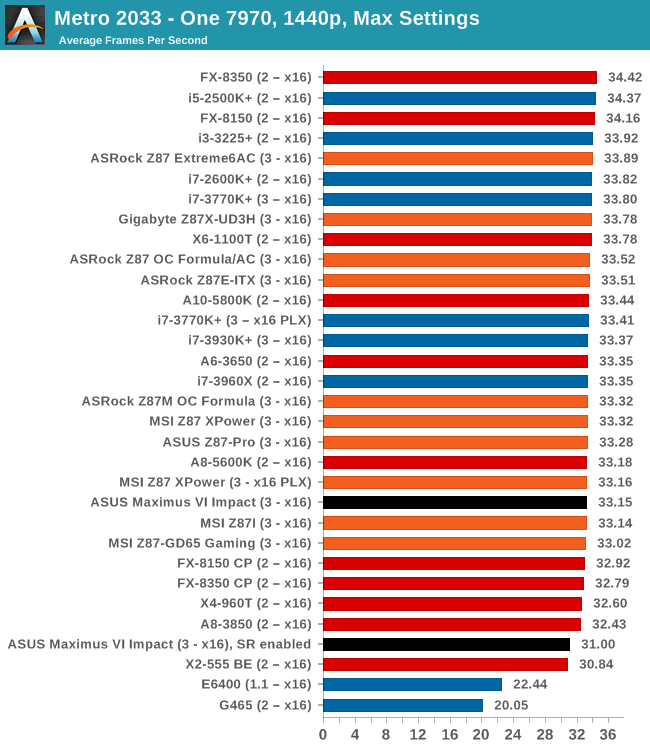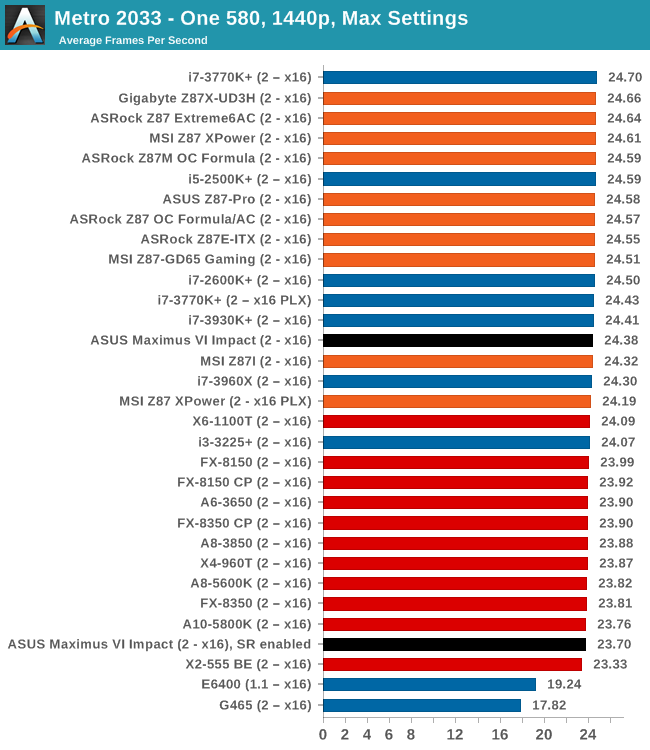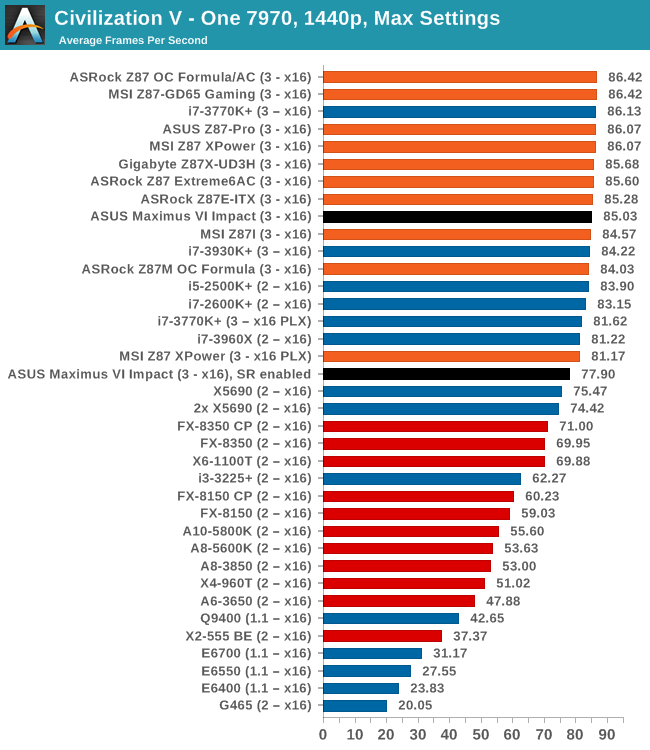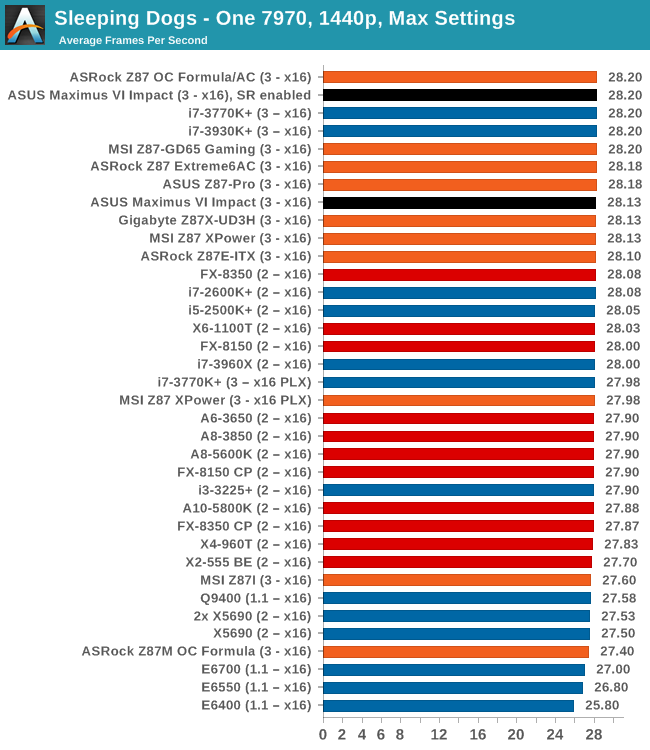ASUS Maximus VI Impact Review: ROG and Mini-ITX
by Ian Cutress on November 22, 2013 10:00 AM ESTGaming Benchmarks
While writing this review and inputting the benchmark numbers into my custom database, I came across a significant discrepancy in the gaming benchmark performance of the Impact against other motherboards in three out of four of our gaming tests. In our testing configurations, we saw a 2 FPS dip against other Z87 motherboards. The culprit it seems is Sonic Radar, the new software designed to aid gamers with a visual representation of directional audio. To put this into perspective, this is what I saw in my testing with Metro 2033:
Settings: 1440p, max everything. CPU at stock, XMP enabled, benchmark mode.
With Sonic Radar enabled, 31.00 FPS and the following frame rate graph:
Without Sonic Radar enabled, 33.15 FPS and the following frame rate graph:
Now it is painfully obvious that the FPS graph with Sonic Radar is manic. Regular fluctuations up to 300 FPS are noticeable at this level of gameplay, whereas it was not noticeable in Dirt 3. This is the first generation of Sonic Radar release, and I am conversing with ASUS whether there is something fundamental with Sonic Radar, or my system setup, that is causing this affect. I have put both SR and non-SR numbers in the benchmark results below.
Metro2033
Our first analysis is with the perennial reviewers’ favorite, Metro2033. It occurs in a lot of reviews for a couple of reasons – it has a very easy to use benchmark GUI that anyone can use, and it is often very GPU limited, at least in single GPU mode. Metro2033 is a strenuous DX11 benchmark that can challenge most systems that try to run it at any high-end settings. Developed by 4A Games and released in March 2010, we use the inbuilt DirectX 11 Frontline benchmark to test the hardware at 1440p with full graphical settings. Results are given as the average frame rate from a second batch of 4 runs, as Metro has a tendency to inflate the scores for the first batch by up to 5%.


Dirt 3
Dirt 3 is a rallying video game and the third in the Dirt series of the Colin McRae Rally series, developed and published by Codemasters. Dirt 3 also falls under the list of ‘games with a handy benchmark mode’. In previous testing, Dirt 3 has always seemed to love cores, memory, GPUs, PCIe lane bandwidth, everything. The small issue with Dirt 3 is that depending on the benchmark mode tested, the benchmark launcher is not indicative of game play per se, citing numbers higher than actually observed. Despite this, the benchmark mode also includes an element of uncertainty, by actually driving a race, rather than a predetermined sequence of events such as Metro 2033. This in essence should make the benchmark more variable, but we take repeated in order to smooth this out. Using the benchmark mode, Dirt 3 is run at 1440p with Ultra graphical settings. Results are reported as the average frame rate across four runs.


Civilization V
A game that has plagued my testing over the past twelve months is Civilization V. Being on the older 12.3 Catalyst drivers were somewhat of a nightmare, giving no scaling, and as a result I dropped it from my test suite after only a couple of reviews. With the later drivers used for this review, the situation has improved but only slightly, as you will see below. Civilization V seems to run into a scaling bottleneck very early on, and any additional GPU allocation only causes worse performance.
Our Civilization V testing uses Ryan’s GPU benchmark test all wrapped up in a neat batch file. We test at 1080p, and report the average frame rate of a 5 minute test.


Sleeping Dogs
While not necessarily a game on everybody’s lips, Sleeping Dogs is a strenuous game with a pretty hardcore benchmark that scales well with additional GPU power due to its SSAA implementation. The team over at Adrenaline.com.br is supreme for making an easy to use benchmark GUI, allowing a numpty like me to charge ahead with a set of four 1440p runs with maximum graphical settings.














69 Comments
View All Comments
jihe - Thursday, November 28, 2013 - link
You can pick up an old cpu for a dime. Think about the among if of engineering and fabrication in that.HighOnMikey - Friday, November 22, 2013 - link
I have this and a BitFenix Prodigy. Beautiful combo, if you ask me. Anyway I use this as my main/gaming desktop with Windows 8.1. While an improvement, boot times are still between 12-17 seconds. Windows 8.1 also introduces several issues with stability, something I didn't experience quite as much with Windows 8. I also experienced the same issues with SonicRadar, but the FPS drop was more severe using a very similar setup with the exception of a GeForce GTX 680. Great board.stennan - Friday, November 22, 2013 - link
How many Pcie lanes are linked to the m2 connection? will we be able to get speeds above sata3?Morawka - Saturday, November 23, 2013 - link
nope.avi. ASUS is retarded and put the m.2 on a PCI 1X Busu.of.ipod - Friday, November 22, 2013 - link
Really disappointed to see no use of the M.2 slot in this review. One of the biggest reasons I want to use this board.Morawka - Saturday, November 23, 2013 - link
Asus botched it this time around. They put the M.2 Connector on a PCI 1X Bus, which severely limits what these SSD's are capable of.JoanSpark - Friday, November 22, 2013 - link
I thought there was a mITX review coming in?lorribot - Friday, November 22, 2013 - link
Oh look woopie woo aren'y we clever we can stick a whole bunch of stuff on a tiny board and chrge you the same as a big board.Er actually no your not.
What I want is a quality ITX board with aout all the rubbish. If I buy a Z board I am going to be overclocking, do I need any video out put on the back panel? No. DO i want SPDIF? No. DO I need 4 SATA? No, just the two. DO i need Wifi, no just a standard 1 Gb Nic.
When will a Mobo comapany actually stop trying to be clever and produce a resonably priced Z board with basics and nothing more for about a 1/3 of the price of this beastie?
Make that I may just think you are a bit clever ASUS et al.
extide - Friday, November 22, 2013 - link
Check out the ASRock Z87 ITXlorribot - Saturday, November 23, 2013 - link
Would that be the 127GBP/$160 Z87E-ITX? The one with Wi-fi built in?Not exact 1/3 of the price that one.
I would rather spend an extra £50-60 on upgrading processor or graphics card than MOBO features I never use.